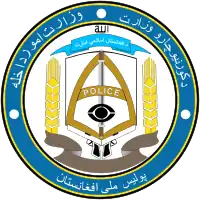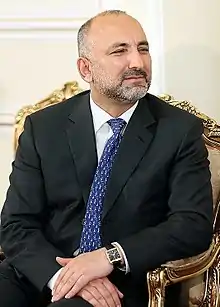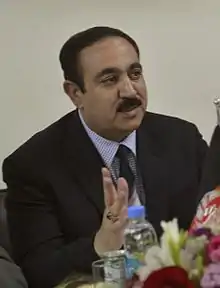 Emblem of the Ministry of Interior Affairs of the Islamic Emirate of Afghanistan | |
| Government agency overview | |
|---|---|
| Jurisdiction | Government of Afghanistan |
| Headquarters | Kabul 34°34′04.13″N 69°10′42.82″E / 34.5678139°N 69.1785611°E |
| Motto | Resolute. Ready. Responsive. |
| Minister responsible | |
| Deputy Ministers responsible | |
| Government agency executives | |
| Website | moi |
 |
|---|
|
|
The Ministry of Interior Affairs (Persian: وزارت امور داخله افغانستان, Pashto: د افغانستان د کورنیو چارو وزارت) is the cabinet ministry of Afghanistan responsible for law enforcement, civil order and fighting crime. The ministry's headquarters is located in Kabul.
The current minister of Interior Affairs is Sirajuddin Haqqani, who is also the first deputy leader of Afghanistan and the leader of the Haqqani network.
List of ministers
| Portrait | Name | Took office | Left office | Political affiliation | |
|---|---|---|---|---|---|
| Abd al-Ghafur Khan[3] | January 1929 | 1929 | Saqqawist | ||
| Mohammad Gul Khan Momand | 1930s | Independent | |||
| Faiz Mohammed | 1973 | 1975 | Independent | ||
| Abdul Qadir Nuristani | 1975 | 28 April 1978 | Republican | ||
| Nur Ahmed Nur[4] | 30 April 1978 | 11 July 1978 | PDPA–Parcham | ||
 |
Mohammad Aslam Watanjar[5] | 11 July 1978 | 1 April 1979 | PDPA–Khalq | |
| Shir Jan Mazdooryar[6] | 1 April 1979 | 28 July 1979 | PDPA–Khalq | ||
 |
Mohammad Aslam Watanjar[7] | 28 July 1979 | 19 September 1979 | PDPA–Khalq | |
| Vacant (19 September – 28 December 1979) | |||||
| Sayyed Mohammed Gulabzoi[8] | 28 December 1979 | 15 November 1988 | PDPA–Khalq | ||
 |
Mohammad Aslam Watanjar[9] | 15 November 1988 | 6 March 1990 | PDPA–Khalq | |
| Raz Muhammad Paktin[10] | 6 March 1990 | 16 April 1992 | Homeland Party | ||
| Abdul Samad Khaksar[lower-alpha 1] | 1996 | 2001 | Taliban | ||
| Qari Ahmadullah | 1996 | ? | Taliban | ||
 |
Khairullah Khairkhwa | 1997 | 1998 | Taliban | |
| Abdur Razzaq | ? — May 2000 — ? | Taliban | |||
 |
Yunus Qanuni | 7 December 2001 | 19 June 2002 | ||
| Taj Mohammad Wardak | 19 June 2002 | 28 January 2003 | |||
.jpg.webp) |
Ali Jalali | 28 January 2003 | 27 September 2005[11] | Independent | |
 |
Zarar Ahmad Osmani[lower-alpha 2] | 28 September 2005 | 11 October 2008 | ||
 |
Mohammad Hanif Atmar | 11 October 2008 | July 2010 | Independent | |
_(cropped).jpg.webp) |
Bismillah Khan Mohammadi | July 2010 | September 2012 | Jamiat-e Islami | |
 |
Mujtaba Patang | 15 September 2012 | 22 July 2013 | Independent (Police) | |
 |
Mohammad Omar Daudzai | 1 September 2013 | 9 December 2014 | Independent | |
 |
Mohammad Ayub Salangi (acting) |
9 December 2014 | 27 January 2015 | Independent (Police) | |
 |
Nur ul-Haq Ulumi | 27 January 2015 | 24 February 2016 | Hezb-e Muttahed-e Melli | |
.jpg.webp) |
Taj Mohammad Jahid | 24 February 2016 | 13 August 2017 | Jamiat-e Islami | |
| Wais Barmak | 13 August 2017 | 23 December 2018 | Independent | ||
.jpg.webp) |
Amrullah Saleh (acting) |
23 December 2018 | 19 January 2019 | Basej-e Milli | |
| Masoud Andrabi | 19 January 2019 | 19 March 2021 | |||
 |
Hayatullah Hayat (acting) |
19 March 2021[13] | 19 June 2021 | Independent | |
| Abdul Sattar Mirzakwal (acting) |
19 June 2021[14] | 15 August 2021 | Independent (Military) | ||
| Ibrahim Sadr (acting) |
24 August 2021 | 7 September 2021 | Taliban | ||
.png.webp) |
Sirajuddin Haqqani (acting) |
7 September 2021[15] | Incumbent | Taliban (Haqqani network) | |
The Democratic Republic period
During the period where Afghanistan was a Marxist-Leninist state under the People’s Democratic People of Afghanistan, those that worked for the Ministry of Interior (MoI) were referred to as “Sarandoy”.[16] This label included traffic police, provinical officers and corrections/labor prison facility officers. The Ministry of Interior also had female personnel who were tasked with interacting with female civilians, such as when searching them at checkpoints. Those who worked for the Ministry of Interior were tasked with fighting “counter-revolutionaries”, securing government and party components and ensuring the safety of important structures. As of 1982, the Ministry of Interior may have had its own intelligence agency. The Sarandoy were a centrally commanded force and companies, battalions, and brigades reported to the “Directorate of the Defense of the Revolution of the Ministry of Interior”.
It should also be noted that a gendarme forces also existed during Daoud Khan’s republic, and that personnel under the Ministry of Interior were trained by Turkey from the 1950s well into the 1970s. Additionally, both West Germany and East Germany trained those in the Ministry of Interior and on the eve of the Saur Revolution in 1978, Afghanistan’s officer corps and MoI personnel contained personnel who received training in the United States. Regardless, the Sarandoy had far more numbers and were more effective due to the cooperation of the Soviet MVD and its “Kobalt” units in 1981 and 1982 where 12,000 of these Sarandoy personnel were trained at MVD facilities in the Soviet Union between 1978 and 1986, many of them being junior commanders and NCOs. 2,500 of these Sarandoy personnel would be trained in Tashkent, the capital of Uzbek Soviet Socialist Republic for past excellence in combat.
The first Islamic Emirate period
During the Islamic Emirate of Afghanistan (1996–2001), Abdul Samad Khaksar (also referred to as Mohammad Khaksar in some news reports) was a Taliban deputy Minister of the Interior, who is notable because he offered to help the US deal with al-Qaeda and became an informant for the Northern Alliance. Khaksar was assassinated on January 14, 2006 by Taliban gunmen.[17][18]
Joint Task Force Guantanamo counterterrorism analysts described Khairullah Khairkhwa as a former Taliban Minister of the Interior.[19][20][21] However, during his second annual Administrative Review Board hearing Khairullah Khairkhwa disputed this allegation.
The Islamic Republic period
_(2001-2021).svg.png.webp)
During the Islamic Republic of Afghanistan (2004–2021), the ministry maintained the Afghan National Police, the General Command of Police Special Units and the General Directorate of Prisons and Detention Centers (GDPDC).[23][24]
Police forces
- Afghan National Police (ANP)[25]
- Afghan Uniformed Police (AUP)[25]
- Public Security Police (PSP)[25]
- Afghan Border Force (ABP)[25]
- General Directorate for Intelligence and Counter Crime (GDICC) (formerly Afghan Anti-Crime Police (AACP))[26]
- Afghan Public Protection Force (APPF)[27]
- Counter Narcotics Police of Afghanistan (CNPA)[27]
- Afghan Local Police (ALP)[27]
- General Command of Police Special Units (GCPSU)[28][29]
- Afghan Territorial Force (ATF) 444[29]
- Crisis Response Unit (CRU) 222[29]
- Afghan Special Narcotics Force - also known as Force 333 or Commando Force 333.[30] The force was a counternarcotics paramilitary unit, founded at the end of 2003 with training and assistance from British advisers. It carried out drug interdiction missions in remote areas of the country against high-value targets such as drug laboratories. The Department of Defense provided the unit with intelligence and airlift support.[31][32] All of its operations were sanctioned by the President and Minister of Interior Affairs. It operated regularly with the U.S. Drug Enforcement Administration on raids and seized hundreds of tonnes of illicit drugs.[33]
- Provincial Special Units[29][30]
Notes
See also
References
- ↑ https://www.pakistanpoint.com/en/story/1375561/afghan-government-creates-commission-to-root-out-corrup.html
- ↑ "مولوي بدرالدین حقاني د کورنیو چارو وزارت د تدارکاتو د رییس په توګه وټاکل شو | د کورنیو چارو وزارت". moi.gov.af.
- ↑ Muḥammad, Fayz̤; McChesney, R. D. (1999). Kabul under siege: Fayz Muhammad's account of the 1929 Uprising. Markus Wiener Publishers. pp. 57, 58. ISBN 9781558761544.
- ↑ Male, Beverly (1982). Revolutionary Afghanistan: A Reappraisal. Croom Helm. p. 107. ISBN 0709917163.
- ↑ Male, Beverly (1982). Revolutionary Afghanistan: A Reappraisal. Croom Helm. p. 111. ISBN 0709917163.
- ↑ Male, Beverly (1982). Revolutionary Afghanistan: A Reappraisal. Croom Helm. pp. 139, 140. ISBN 0709917163.
- ↑ Male, Beverly (1982). Revolutionary Afghanistan: A Reappraisal. Croom Helm. p. 155. ISBN 0709917163.
- ↑ Bradsher, Harry (1999). Afghan Communism and Soviet Intervention. Oxford University Press. pp. 121, 313. ISBN 0195790170.
- ↑ Bradsher, Harry (1999). Afghan Communism and Soviet Intervention. Oxford University Press. pp. 313, 342. ISBN 0195790170.
- ↑ Bradsher, Harry (1999). Afghan Communism and Soviet Intervention. Oxford University Press. pp. 342, 381. ISBN 0195790170.
- ↑ "Afghanistan: Top Security Official Resigns Amid Controversy". Radio Free Europe. 28 September 2005. Retrieved 27 February 2007.
- ↑ Mudassir Ali Shah (30 September 2005). "Karzai, Musharraf vow joint anti-terror drive". Daily Times. Pakistan. Archived from the original on 30 September 2007. Retrieved 27 February 2007.
- ↑ "Hayat replaces Andarabi as acting interior minister". Pajhwok Afghan News. 19 March 2021. Retrieved 19 March 2021.
- ↑ "Afghan president replaces security ministers amid Taliban advance". 19 June 2021. Retrieved 27 June 2021.
- ↑ "Taliban announce new government for Afghanistan". BBC News. 7 September 2021. Archived from the original on 7 September 2021. Retrieved 7 September 2021.
- ↑ https://www.rand.org/content/dam/rand/pubs/monographs/2011/RAND_MG1078.pdf
- ↑ "Afghan president condemns assassination of former interior minister". Xinhua. People's Daily. 16 January 2006. Retrieved 27 February 2007.
- ↑ Scott Baldauf (15 October 2004). "Peaceful vote diminishes Taliban: The Afghan rebels had threatened violence to disrupt Saturday's elections, but failed to deliver". Christian Science Monitor. Retrieved 27 February 2007.
- ↑ OARDEC (7 October 2005). "Unclassified Summary of Evidence for Administrative Review Board in the case of Khairkhwa, Khirullah Said Wali" (PDF). United States Department of Defense. pp. 38–41. Archived from the original (PDF) on 4 December 2007. Retrieved 7 October 2007.
- ↑ OARDEC (16 June 2006). "Unclassified Summary of Evidence for Administrative Review Board in the case of Khairkhwa, Khirullah Said Wali" (PDF). United States Department of Defense. pp. 83–85. Archived from the original (PDF) on 3 December 2007. Retrieved 7 October 2007.
- ↑ OARDEC (June 2006). "Summary of Administrative Review Board Proceedings for ISN 579" (PDF). United States Department of Defense. pp. 34–44. Archived from the original (PDF) on 10 May 2008. Retrieved 7 October 2007.
- ↑ "MoI Expects Better Security After Changes In Leadership". TOLOnews. Retrieved 17 October 2021.
- ↑ United States. Department of Defense (December 2020). Enhancing Security and Stability In Afghanistan (PDF). pp. 57, 59. 7-653B15D. Retrieved 21 August 2021.
- ↑ "2013 Country Reports on Human Rights Practices - Afghanistan" (PDF). The United States Department of Justice. United States Department of State. 27 February 2014. p. 5. Archived (PDF) from the original on 20 August 2021. Retrieved 20 August 2021.
- 1 2 3 4 Department of Defense 2020, p. 58.
- ↑ Department of Defense 2020, pp. 58–59.
- 1 2 3 Department of Defense 2020, p. 59.
- ↑ Department of Defense 2020, pp. 59–60.
- 1 2 3 4 Helmus, Todd C. (2015). Advising the Command : Best Practices from the Special Operation's Advisory Experience in Afghanistan (PDF). Santa Monica, CA: RAND Corporation. p. 2. ISBN 9780833088918. Retrieved 21 August 2021.
- 1 2 Department of Defense 2020, p. 60.
- ↑ Christopher M. Blanchard (December 2009). Afghanistan: Narcotics and U. S. Policy. DIANE Publishing. pp. 39–. ISBN 978-1-4379-1922-6.
- ↑ Steve Bowman (November 2010). War in Afghanistan: Strategy, Military Operations, and Issues for Congress. DIANE Publishing. pp. 50–. ISBN 978-1-4379-2698-9.
- ↑ William R. Brownfield (May 2011). International Narcotics Control Strategy Report: Volume I: Drug and Chemical Control. DIANE Publishing. pp. 98–. ISBN 978-1-4379-8272-5.
External links
- Official site
- Ministry of Interior Affairs- Afghanistan on Twitter
- Official site of the Afghan Public Protection Force